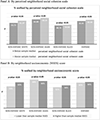Race and Ethnicity Differences in Walking and Associations with Neighborhood Perceptions among Older Adults in California
- PMID: 35959781
- PMCID: PMC9671857
- DOI: 10.1177/07334648221118902
Race and Ethnicity Differences in Walking and Associations with Neighborhood Perceptions among Older Adults in California
Abstract
This paper estimates differences in walking and associations of walking with neighborhood perceptions among older adults in California. We analyzed the restricted-use California Health Interview Survey data merged with the American Community Survey data. Walking at least 10 minutes for leisure in the last 7 days and number of minutes walked were regressed on perceived neighborhood social cohesion scale (PNSCS) and neighborhood socioeconomic characteristics. We estimated ordinary least squares regression models. We found that positive neighborhood perceptions were significantly (p< 0.05) associated with walking among older Hispanic and Asian adults. Older Hispanic adults with above median PNSCS report that they walk 6.3 percentage points more than Non-Hispanic White adults. Older adults' perceptions of their neighbors and neighborhoods are positively correlated with walking. Policymakers can consider ways to improve neighborhood perceptions and relationships to help increase walking among minority older adults especially in low SES neighborhoods.
Keywords: Health behaviors; minority older adults; neighborhood perception; social cohesion; walking.
Conflict of interest statement
The authors declare that there is no conflict of interest.
Figures


Similar articles
-
Walking for transportation or leisure: what difference does the neighborhood make?J Gen Intern Med. 2007 Dec;22(12):1674-80. doi: 10.1007/s11606-007-0400-4. Epub 2007 Oct 12. J Gen Intern Med. 2007. PMID: 17932724 Free PMC article.
-
Correlates of neighborhood environment with walking among older Asian Americans.J Aging Health. 2015 Feb;27(1):17-34. doi: 10.1177/0898264314535636. Epub 2014 Jun 17. J Aging Health. 2015. PMID: 24943112
-
Neighborhood Social Cohesion and Loneliness in Mid- and Later Life: Are Benefits Contingent on Race/Ethnicity or Neighborhood Disorder?J Gerontol B Psychol Sci Soc Sci. 2023 Aug 28;78(9):1581-1590. doi: 10.1093/geronb/gbad081. J Gerontol B Psychol Sci Soc Sci. 2023. PMID: 37218292
-
Walking Among California Adults.Policy Brief UCLA Cent Health Policy Res. 2018 Sep;2018(7):1-8. Policy Brief UCLA Cent Health Policy Res. 2018. PMID: 30311766
-
Neighborhood Social Cohesion and Walking Limitations in Ethnically Diverse Older Latinos in the United States.Ethn Dis. 2019 Apr 18;29(2):247-252. doi: 10.18865/ed.29.2.247. eCollection 2019 Spring. Ethn Dis. 2019. PMID: 31057309 Free PMC article.
References
-
- Adkins A, Barillas-Longoria G, Nevárez Martínez D, & Ingram M (2019). Differences in social and physical dimensions of perceived walkability in Mexican American and non-hispanic white walking environments in Tucson, Arizona. Journal of Transport and Health, 14, 100585. 10.1016/j.jth.2019.100585 - DOI - PMC - PubMed
-
- Babey SH, Wolstein J, & Diamant AL (2018). Walking Among California Adults. - PubMed
-
- Barnett DW, Barnett A, Nathan A, Van Cauwenberg J, & Cerin E (2017). Built environmental correlates of older adults’ total physical activity and walking: A systematic review and meta-analysis. In International Journal of Behavioral Nutrition and Physical Activity (Vol. 14, Issue 1, pp. 1–24). BioMed Central Ltd. 10.1186/s12966-017-0558-z - DOI - PMC - PubMed

